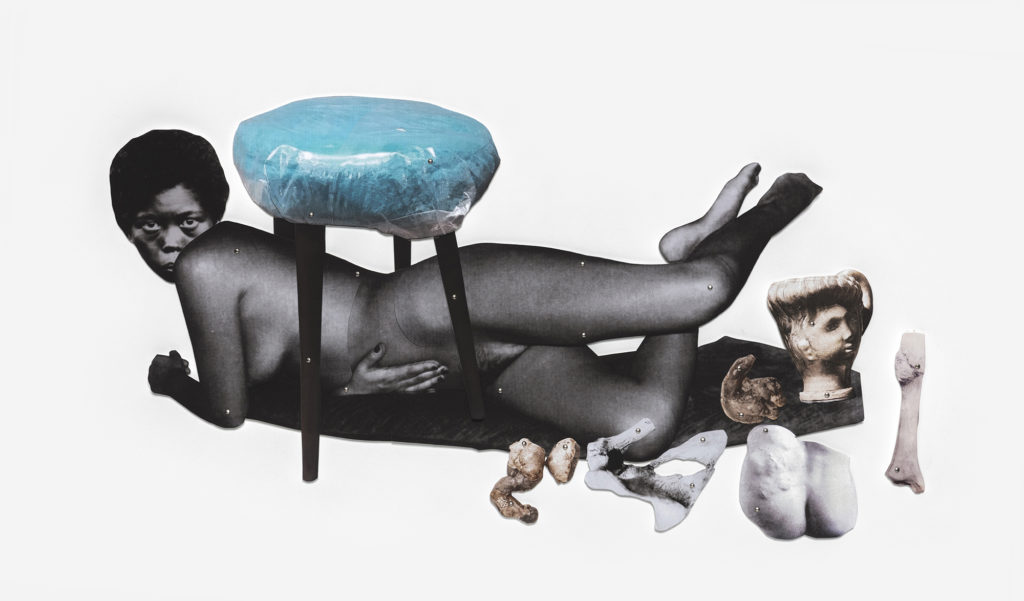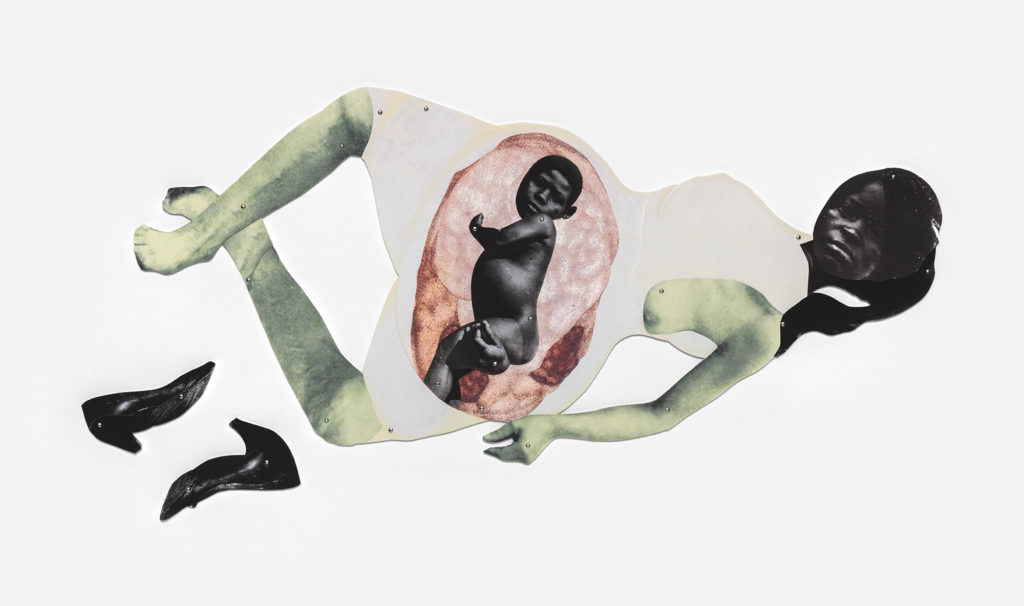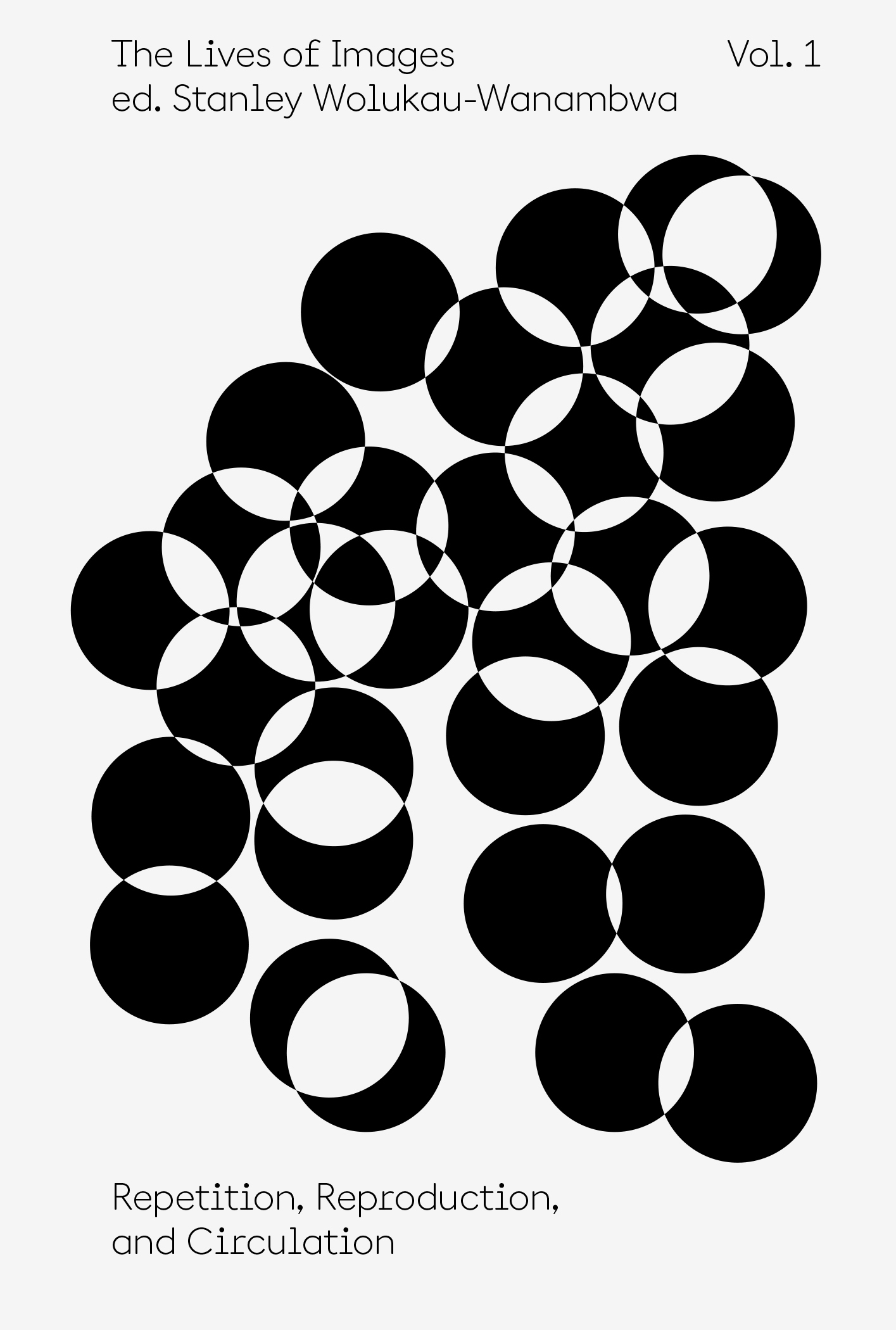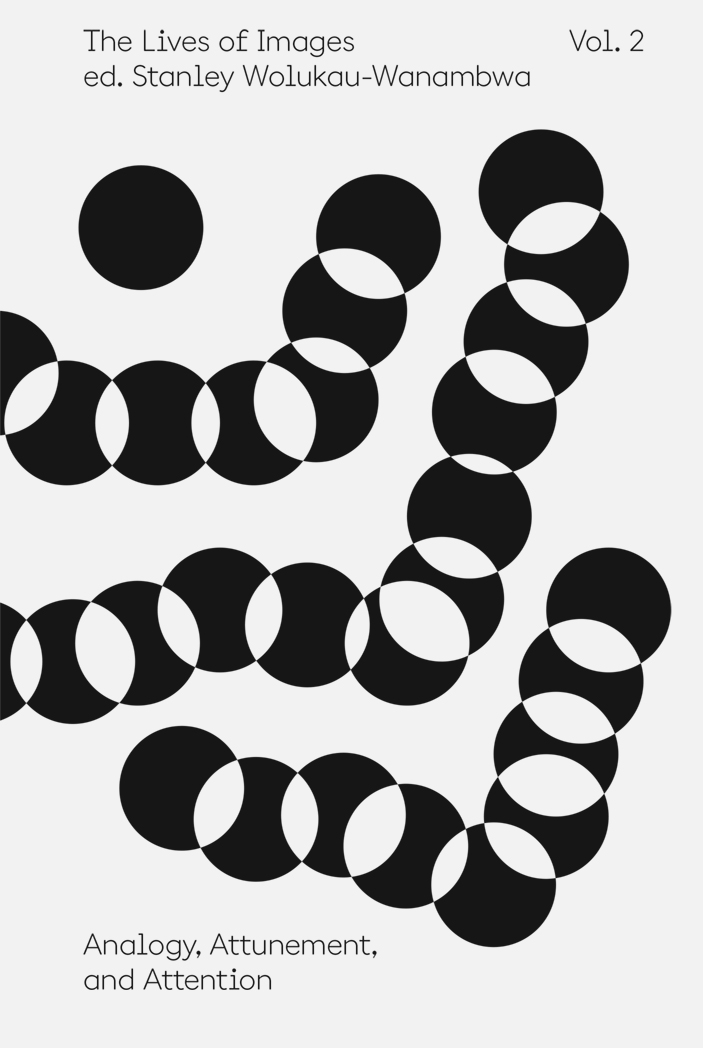In Frida Orupabo’s Collages, the Black Feminine Figure Is a Rich Expressive Force
Using photographs in her multidisciplinary work, Orupabo creates narratives that oppose stereotypical ideas of what it means to be a Black woman.
Frida Orupabo, Untitled, 2018. Digital collage
Courtesy the artist
Frida Orupabo is a sociologist and artist whose practice spans photography, collage, sculpture, and video. Her artistic work fashions new objects, images, and moving-image sequences from extant images sourced from a variety of common sources, like the internet, as well as from various institutional and parainstitutional archives. The history and presence of the Black woman and the symbolic and material force of Black gender nonconformity sit at the center of Orupabo’s artist work, and these factors surface through collaged figures which she (re)assembles in digital space and (re)produces as sculptural aggregates. In Orupabo’s collages, the Black feminine figure is both a site for reparative work and an agent of rich expressive force: she is taped and riveted together from historical fragments, but possessed of an irreducible scopic power to look back at our looking—from her stance on the margins of history, but at the center of Orupabo’s image world.

Courtesy the artist and Stevenson Gallery, Amsterdam, Cape Town, and Johannesburg. Photograph by Mario Todeschini
Stanley Wolukau-Wanambwa: I’m curious to better understand how images accumulate in your personal archives, both digital and physical, and then how they might slowly or suddenly be transformed into the scaled prints and sculptural objects out of which you make your collages. How are you encountering images, and accumulating, assessing, and exploring them in digital and physical form?
Frida Orupabo: Most of the images I accumulate and work with are digital. I use different platforms (like Tumblr, Pinterest, Instagram, eBay, Etsy, and Google, among others). Google is often used when I’m already tracking something, when I am actively looking for very specific things; this is often the case when I’m working on a digital collage and need things along the way—a shoe, a pregnant belly, etc. While other times I am more in “research” mode, where one finding leads to another.
It’s hard to speak to how I encounter images or how I am exploring them in digital and physical form, because the whole process (of searching, finding, accumulating, and making use of them) is very intuitive. Some images just make me stop. It can be a person’s face or something about the whole composition or arrangement of objects in a room. Or it can just be something I haven’t seen before—a twist on something that is familiar.
When starting on a digital collage, I will begin with something I really like and then go back and forth—testing different parts that will accompany the first piece. The selection of the different parts is done based on how they or it feel(s). It’s like a silent knowledge and a big trust of one’s own eye.

Courtesy the artist
Wolukau-Wanambwa: How do you begin to work out a physical scale for the collages? Do they come together digitally first, before becoming scaled objects in space?
Orupabo: Yes, the digital collage is always the starting point, the base for the physical collage. I enlarge it (in Photoshop) and then print it, stitching together all of the layers (first by using tape, then pins). Usually, the collages will be close to human size or bigger. It depends on the project and the space, and how I would like to organize the images (individually or grouped together). The space I am working in—which is my apartment—naturally also sets a limit to how big I can make them.
The first time I enlarged and printed out a digital collage, I was so delighted and a bit startled to experience how present she (the collage) felt in the room, and I immediately knew that this was how they should be presented. Before, I had looked at the digital collages as done; but after this, I started to see them more as sketches.
When it comes to the sculptures, I will use more time finding the right scale. I will make a physical test where I use paper or cardboard. Then all of the info and sometimes even the tests and mock-up will be sent to the company that is going to realize it.
Wolukau-Wanambwa: How do you think about the gesture or grammar of creating Black figures—principally Black female figures, although arguably also Black gender-nonconforming figures—through the language of collage?
Orupabo: I think of it as something liberating, and as something very closely linked to creating and sustaining one’s own self. I see collage as an effective way of questioning and recreating narratives and identities, by combining images that originally were not meant to stand together; to take apart, leave out, bring together. I feel that the layering reveals complexities and contradictions—things that makes us human, but which often are denied Black people within Western discourses.
Wolukau-Wanambwa: Can I ask if you’re thinking principally of the liberation of the depicted figures? (And I guess we’d center here on the faces of the figures.) This idea of liberation through archival practices of reassembly brings to mind a broader set of intellectual, theoretical, and artistic practices of fabulation. But is the liberation yours personally, as well as that of the depicted figure, as you construe the effects of collage?
Orupabo: Liberation might be a strong word, but it is how it feels when working on something. I feel totally free. Just like bell hooks has described her relationship with theory—seeing it as a place of belonging, and healing—I would describe my relationship to my own work the same way.
I am not only speaking about the finished collage (what it addresses or questions), but the whole process of getting there. It’s about my own lived experience and truth, which of course cannot be separated from the political. Or, as Grada Kilomba has said, “My biography theorizes something.”
I don’t think I would say that I am liberating the depicted figures. I would rather say I am trying to recontextualize the images.

Courtesy the artist and Stevenson Gallery, Amsterdam, Cape Town, and Johannesburg. Photograph by Mario Todeschinini
Wolukau-Wanambwa: I’m drawn to the hybridity of your figures, whom I would tentatively describe as Black women—tentatively, because it’s clear that your figures are assemblages of multiple bodies, and that there’s an element of gender nonconformity at play that exceeds the cisgender frame of womanhood. But in thinking about Kilomba and also a kind of hybridity of personhood grounded in Blackness and Black histories, I hear echoes of Hortense Spillers from her essay “Interstices: A Small Drama of Words” [2003], in which she writes:
A feminist critique in the specific instance of sexuality would encourage a counter-narrative in pursuit of the provenance and career of word- and image-structures in order that agent, agency, act, scene, and purpose regain their differentiated responsiveness. The aim, though obvious, might be restated: to restore to women’s historical movement its complexity of issues and supply the right verb to the subject searching for it, feminists are called upon to initiate a corrected and revised view of women of color on the frontiers of symbolic action.
It seems to me that you’re also actively engaged in the field of symbolic action, and concerned with Black grammars of personhood, so I wonder if you could talk more about how you think about figuration, agency, the “scene” your work constructs—perhaps in relation to the work’s exhibited forms.
Orupabo: The gaze is important to me, and I see it as linked to agency. I am, for the most part, working with images where the subject gazes directly at the spectator, which (hopefully) makes possible an internal dialogue—engaging people to pose questions like “What do I see?” and “Why?”
You mentioning Spillers made me think of something bell hooks wrote concerning the white feminist movement—that they made woman synonymous with white women and Black synonymous with Black men. Black women were made invisible (or hypervisible). To be white is to be neutral—it defines normality—while everything else is othered and racialized.
I revisited hooks’s writings recently and came across a conversation she had with Carrie Mae Weems [in Art On My Mind: Visual Politics (1995)], where Weems posed the question of whether it is possible to use Black subjects to represent universal concerns, which is something I think about often. I think this question has a strong presence in the process of making, shaping, and also placing my work within a gallery context—like, how to create complex narratives and identities that oppose and break with stereotypical ideas of what it means to be a Black woman.
And so, the twisting of limbs, the gaze, the different bodies and body parts is, for me, an attempt to escape these really narrow and violent understandings or discourses of who I am or who we are.
Wolukau-Wanambwa: Right. Weems says that “Black images can only stand for themselves and nothing more,” implying that they are unable to “create a cultural terrain that we watch and walk on and move through,” as she puts it—that they cannot be universalized as a or our general field. hooks then goes on to distinguish between confrontation and contestation, which reminds me of the level gazes of your figures, gazes I’m considering in this context as a contestation of the programmatic invisibility of Black femininity.
But I imagine that for you, the figures, and Black femininity, cannot ultimately only be grounded in negation—that a whole rich spectrum of Black life lies on the other side of this erasure. I sense that in Untitled [2018], which develops a theatrical scene on which Black women at once attend to small white children in one section of the image, but also wrestle among themselves in leotards behind tree trunks at the other end of the stage.
Can you talk about the visual dramas you create in this context of creating “a cultural terrain that we watch and walk on and move through”?
Orupabo: I like this image. It still interests me—probably because of the composition, as well as the different subjects involved. In a way, they are recognizable (as far as being linked to a specific time and place), but because they are all thrown into the same frame, things are getting more interesting or complex. Past and present are intertwined. The same can be said about their lives. It’s a quiet image, but also very violent. It’s as if they are all there trying to convey their own lived experiences and truths.

Courtesy the artist and the Maxi and Christian Broecking collection. Photograph by Gerhard Kassner
Wolukau-Wanambwa: Can you talk a little more about how you approach making these images, where collaged figures are embedded on top of continuous background scenes? Do you think of or approach these images differently?
Orupabo: Yes, absolutely. I do think about them differently. For instance, they differ from the collages which are, more often than not, portraits of people alone in a frame with a white background or alone floating on a wall (usually a white wall). It adds a narrative or an emotion that I am interested in exploring. For instance, it can be used to say something about belonging—who belongs where and why. That further can speak to not only misrepresentation but also the erasure of Black people’s presence in paintings, photographs, films, etc. And with that, they can be seen as a more direct way of “writing oneself in,” as Octavia Butler and so many others have stressed—to write oneself into a history that has mainly been male, white, and heteronormative.
But they also differ in that I usually make them when I am not working toward something specific. In a way, they are more for me, and therefore a bigger liberty is involved when making them, because I don’t spend time fixing the resolution and so on. They are, in a way, meant to stay small and live inside my computer.

Courtesy the artist and Galerie Nordenhake, Berlin, Stockholm, and Mexico City
Wolukau-Wanambwa: That’s intriguing. I wonder if you could say something about how your Instagram account, @nemiepeba, fits within your artistic practice, but also outside of or unrelated to it. What does the platform afford you, and how do you interact with those that follow you there?
Orupabo: I started my account out of a need to find a space where I could just post images and be quiet and anonymous. It was the perfect “working” environment—a small group of friends and family applauding me quietly from the sidelines, plus some people I didn’t know. It made the platform safe, and I didn’t feel too watched—considering my profile was public.
I have always interacted with people in some way or another on Instagram—mostly with people I already know. But most of the time when I’m there, I am just looking for things, grabbing, downloading, screenshotting, liking, and posting. It used to be a platform where you could also see what other accounts liked and commented on, so IG was (more then than now) a resource to find material for my collages. Though I will say, it is both a medium used to create something apart from it and an artistic practice in itself. It’s hard to draw a line or to separate the two.
This interview was originally published in The Lives of Images, Volume 2: Analogy, Attunement, and Attention (Aperture, 2021), the second in a six-volume set of contemporary thematic readers.
Register for The Lives of Images Symposium Series (November 30–December 2, 2021), presented by Aperture and ICP, featuring conversations with Ariella Azoulay, David Campany, Sarah Cervenak, Saidiya Hartman, Tom Holert, Thomas Keenan, and Stanley Wolukau-Wanambwa.





























